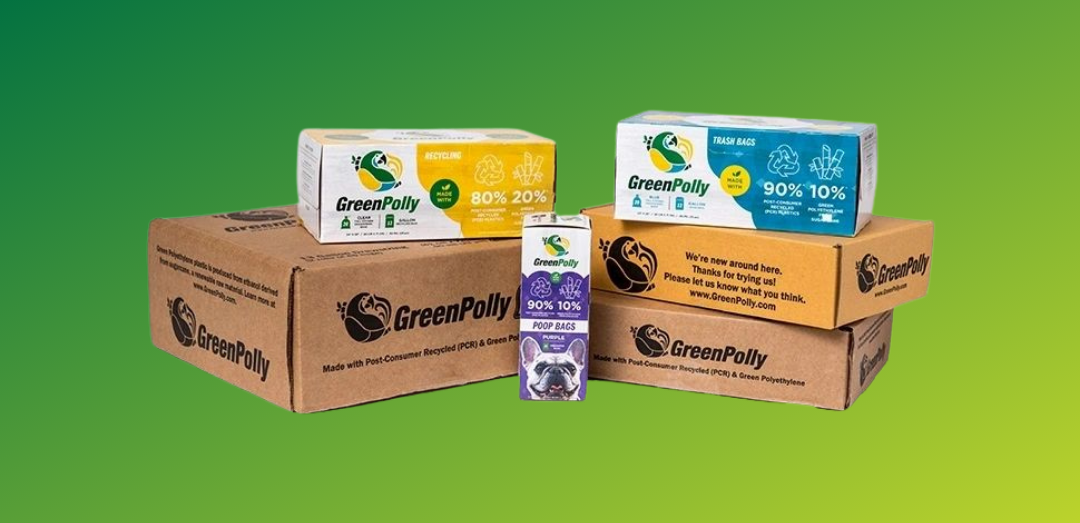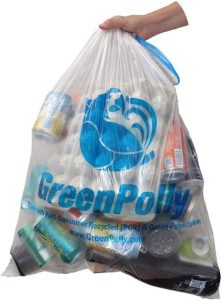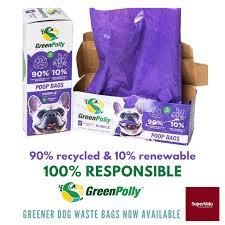
Let me introduce you to GreenPolly. This product is made from beginning to end with a high commitment to sustainability by reusing virgin materials in formulating new products. GreenPolly’s parent company, BioBags, is a brand I trust. BioBags makes compostable liners for organic waste collection. GreenPolly makes plastic liners for trash, recycling, and animal poop.
But what separates GreenPolly’s line of products from BioBags? Simple: GreenPolly’s recycling liner is clear. This liner is made from 80% post-consumer recycled plastics, or PCR, and 20% green polyethylene, or PE, which is made from sugarcane.
What's the big deal about clear bags?
 I am trying to avoid using virgin or single-use plastic liners made from virgin plastics. A clear bag lets me know if the recycling is contaminated. Usually, recycled plastic liners are black, but GreenPolly bags are recycled and clear. I asked a BioBag sales representative, “How are they able to make the bag clear?” The reply? They only use clear liners or plastic shrink wrap as raw materials.
I am trying to avoid using virgin or single-use plastic liners made from virgin plastics. A clear bag lets me know if the recycling is contaminated. Usually, recycled plastic liners are black, but GreenPolly bags are recycled and clear. I asked a BioBag sales representative, “How are they able to make the bag clear?” The reply? They only use clear liners or plastic shrink wrap as raw materials.
One of the most important platforms in the Zero Waste Hierarchy 7.0 is to reuse materials to the best of your ability. Using these clear liners lets me reuse virgin materials. It’s brilliant! Recyclability is another distinctive quality about GreenPolly liners. Generally, recycled liners are not recyclable in addition to being black and opaque. One last great nugget: Greenpolly’s clear liners can be recycled at your local Kroger, Target, and Walmart.
What is PCR?
 PCR stands for post-consumer recycled plastic. , 80-90% of each bag is made with 3rd party certified PCR.
PCR stands for post-consumer recycled plastic. , 80-90% of each bag is made with 3rd party certified PCR.
PCR comes from plastic films that have been used, recovered, and recycled into new products that can be used again. This avoids adding more virgin polyethylene—plastics made directly from oil—to the world by diverting waste from landfills and incinerators.
Source: Click here
What is green PE?
Green polyethylene is produced from sugarcane-derived ethanol, a renewable raw material. Rather than manufactured from non-renewable oil, sugarcane captures CO2 from the atmosphere every annual growth cycle.
Source: click here
What is contamination?
Contamination ranges from food, liquids, and everything in between. If an intended recycled material isn’t cleaned, it’s likely contaminated. Recyclable materials cannot be recycled if they are contaminated. The recyclable plastic will be considered garbage and redirected to the landfill. Although the effort was made to recycle, failing to properly clean and place the recyclable material in the correct recycling bin means all effort was wasted.
The high contamination of recycling materials is the key reason China implemented the National Sword Policy in 2018. The policy bans imported recycled materials if contamination levels are above 0.5%. According to a 2019 study from the National Waste and Recycling Association, the average contamination rate of recyclable materials is 25%. 
GreenPolly liners are purchasable directly from Amazon or your local Whole Foods. Did you know GreenPolly makes liners for pet poop too? Perfect for events, home or work, GreenPolly makes the best compostable bags on the market.

